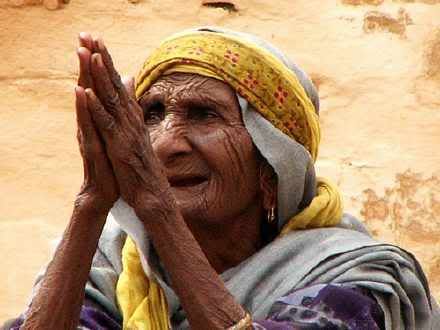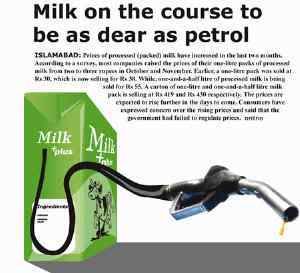Adil Najam
Our educated chattering classes do not consider it sophisticated to talk about milk.

(Photo Credit for this powerful picture: Baba Dody)
They would much rather spend their time pontificating about global geopolitics, the power politics of our would-be-saviors (both those in power and those waiting to come back to power), the intricacies of conspiracy theories about ‘hidden hands’ and not-so-hidden motives, and trying to read the ‘real’ story ‘between lines’ even as they ignore the stark realities of the lines themselves. Of course, for others there is always the option to belch out slogans reeking of pious religosity or self-righteous modernity.
 Ultimately, however, you need to think about the price of milk. Because milk is a necessity and slogans are merely a distraction.
Ultimately, however, you need to think about the price of milk. Because milk is a necessity and slogans are merely a distraction.
I know enough economics to know that while improvements in macro-economic trends matters, they matters much less when the cost of living and making ends meet for the citizenry at large run contrary. We at ATP have been and remain quite concerned about everyday inflationary trends. As we have stressed before, there is something very wrong when the denomination of the highest value banknote (Rs. 5000) is greater than what is considered a decent monthly wage for a middle-class Pakistani! We have also written about just how much it really costs ordinary Pakistanis to get petrol. Now, it turns out that the cost of milk – a daily necessity – is on the rise and moving in the same direction as the cost of petrol.
Many of us tend to think of Pakistan as a place where things are cheaper than in Europe, the US, the Middle East, or elsewhere. I don’t want to go into the math again (see here and here), but this graphic from The Daily Times (3 November, 2006), reminds us yet again that the real cost of living in Pakistan is not just higher than in most other places, for ordinary Pakistanis it is exorbitant.
The text in the graphic reports that most companies have raised the price of their one-litre packs of processed milk, and what used to sell for Rs. 30 is now selling at Rs. 38. Moreover, it reports that the price is likely to increase further.
All of this reminds me of a post Mansoor had recently written in Karachi Metroblog where he posed the question “What exactly can you do with a Million Ruppees?” The answer he came up with was, ‘Not too much!’
A lakh-patti (One Lakh=100,000) is not necessarily rich and depending of how many ‘lakhs’ one has, may even be poor!
The really sad part is that despite all this, most Pakistanis will never know what a Lakh Ruppees look like. And it is we, and not just the ‘authorities’ who are need to accept the blame. For those of you who like to get agitated about things, get agitated about this: The cruelty in society comes not only from the actions of those in power, but from the neglect, the silence, and the inaction of all of us. Indeed, from our willing participation in keeping things as they are.




















































Khalid:
One cannot judge cost of living by a single item. I have come to the conclusion that cost of living is indeed lower in India on average, but certainly not by a factor of two. Prices are lower for most goods, but by a factor of 10-15% on average. Some goods are even cheaper in Pakistan, for instance, telephone calls (they were cheaper in India as recently as two years ago, but the situation has reversed).
The biggest difference in prices between India and Pakistan seems to be for newspapers. Typical national dailies (Times of India, Hindustan Times, Hindu, Indian Express, Telegraph etc.) range in price between Rs. 1.50 and Rs. 3.50 (depending on the degree of competition in the respective cities). Typical dailies in Pakistan seem to cost about Rs. 13-15. (A caveat is that the goods are not strictly comparable unlike say milk)
The penetration of this sector reflects the prices. The circulation of the largest (or at least the most respected) daily in Pakistan, the Dawn, is roughly equal to that of Lokmat Times (an English language daily based out of a small city of Maharashtra called Aurangabad) or the Hitavada (based out of Nagpur) and lower than that for the Pioneer (based out of Lucknow). The penetration of the newspapers will be way higher in Pakistan, if prices come down (and revenues for the newspaper sector will increase due to greater advertising revenues). It would impact the country (positively) in many ways.
A friend had recently told us that Australia was importing cows from Sahiwal for they considered them genetically superior. They are thought to be the only breed that can shrug ticks effectively from their skin.
Owais:
The numbers of milk production seem to be off by a factor of 1000 (it must be kilos and not tons). For a milk production of 31 billion tons is more than the world’s production of milk and would further mean that each buffalo produces about 3T of milk a day on average, rather than about 3kg per day.
BTW, the figures suggest that milk availability in Pakistan is pretty high. India’s average milk availability per capita is about 250g/person/day. In Pakistan, it is of the order of 500g/person/day. Of course, this figure is driven by the province of Punjab (Indian Punjab has a milk availability of almost 1kg/person/day and Haryana and Western UP follow have high milk availability). But it suggests that Pakistan has significant export potential since consumption is likely lower than the average of 500g/day. India has one of the biggest dairy industries in the world, but inadequate export potential because all its production goes towards meeting domestic needs.
Also, productivity of Pakistani buffaloes is quite high (remember that the 3Kg/day figure is averaged over non-milch cows – i.e. male buffaloes and underage/overage female buffaloes). It is lower than the figure for Indian Punjab/Haryana (~5Kg/day), but much higher than the figure for India as a whole (of course, India’s figures are also distorted by the fact that there are much older cattle in the population due to the fact that miniscule numbers are killed for their meat, so averages tend to be downward biased).
To Roshan and others: Indian cooperatives have their own problems that need to be avoided if Pakistan wants to go down this route. Many state cooperatives are sick since they are not run on entrepreneurial lines, but like typical Govt. departments. Corruption and inefficiency have eaten away at cooperative operations in some states (the usual suspects like UP and Bihar have virtually non-existent cooperative operations). Amul (Gujarat) is a huge success across the country and brandnames like Aarey (Maharashtra) and Aavin (Tamil Nadu) are reasonably strong local brands, but the success is not uniform across states.
Khalid, I agree with you. Pakistan’s parallel undocumented economy and its participants are more powerful than people know and can almost dictate terms with the government. True the rupee has lost much of its value over the last few year but still an increase of 30 percent in one shot in milk prices is appalling. In the 80s and 90s we knew the sugar mafia was powerful but over the last decade cement manufacturers have joined the ranks. Remember what happned recently to people who imported cement from China. Govt made them suffer to the last breath after encouraging them to import. Not just that, after all that talk against the cement producers, the PM signed the law stating all roads being built in the country will use cement going forward. Existing stocks of bitumen will be exported (god knows to who). The timing was odd yet no one in the media talks about it. Nor do they talk about the last year’s KSE scam which was huge. When the ex KSE chief blames people in public for a loss in billions it ought to be taken seriously. God also knows why the general is keeping mum on these issues.
Interesting to see that the price of packaged milk in India is in the same price range as fresh unpackaged milk delivered to one’s doorstep in Karachi. The cost of living in India seems to be half of that in Pakistan, judging by this one item.
On the broader point,it is difficult to see why we need a 5000 rupee note when the USA manages with 100 dollar notes. Annual per capita income in the US is around $40,000 whereas Pakistan’s is about Rs.50,000. The undocumented “black” economy is the only one to benefit from it, and it seems strange that the government is tacitly encouraging it through the issue of this note.